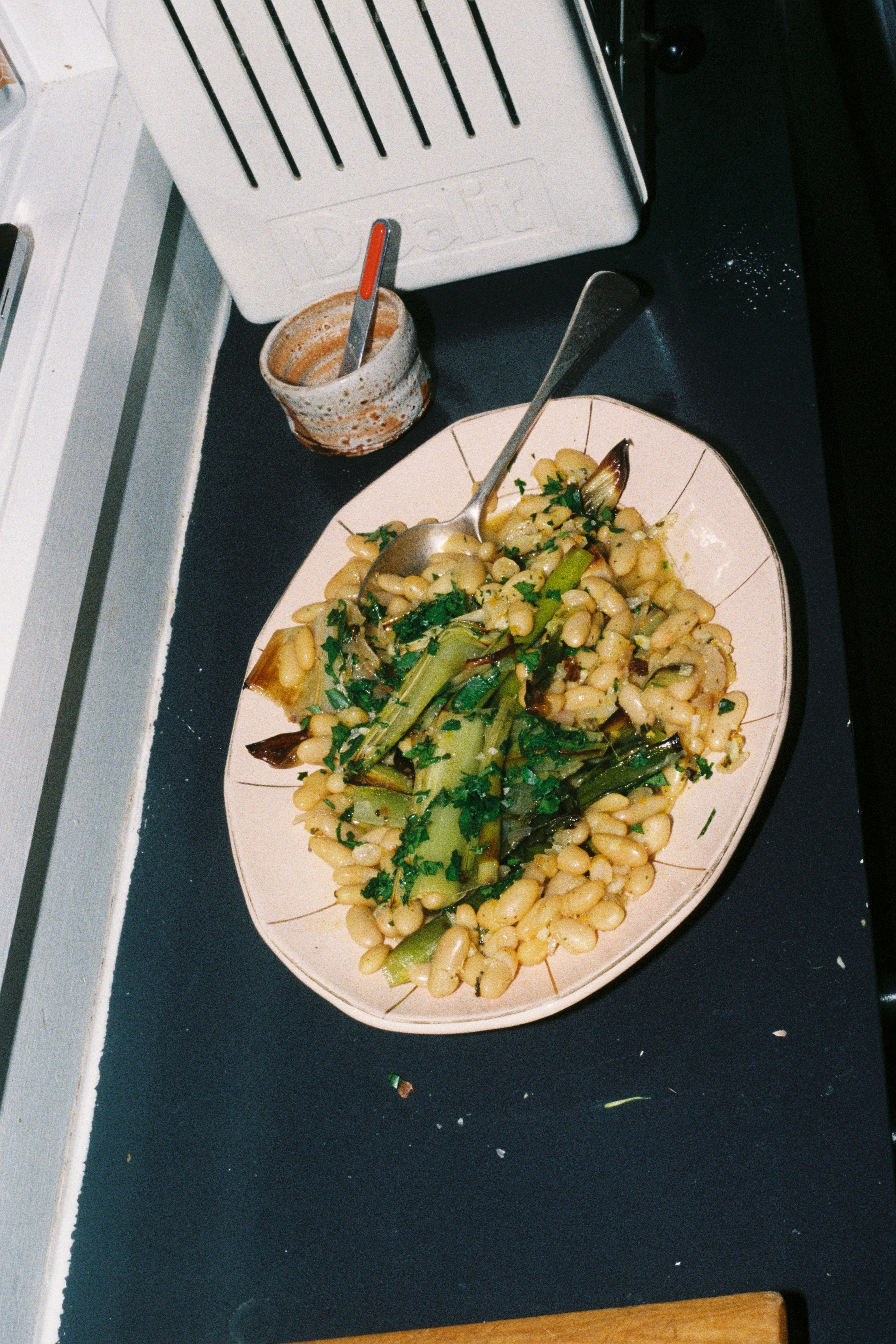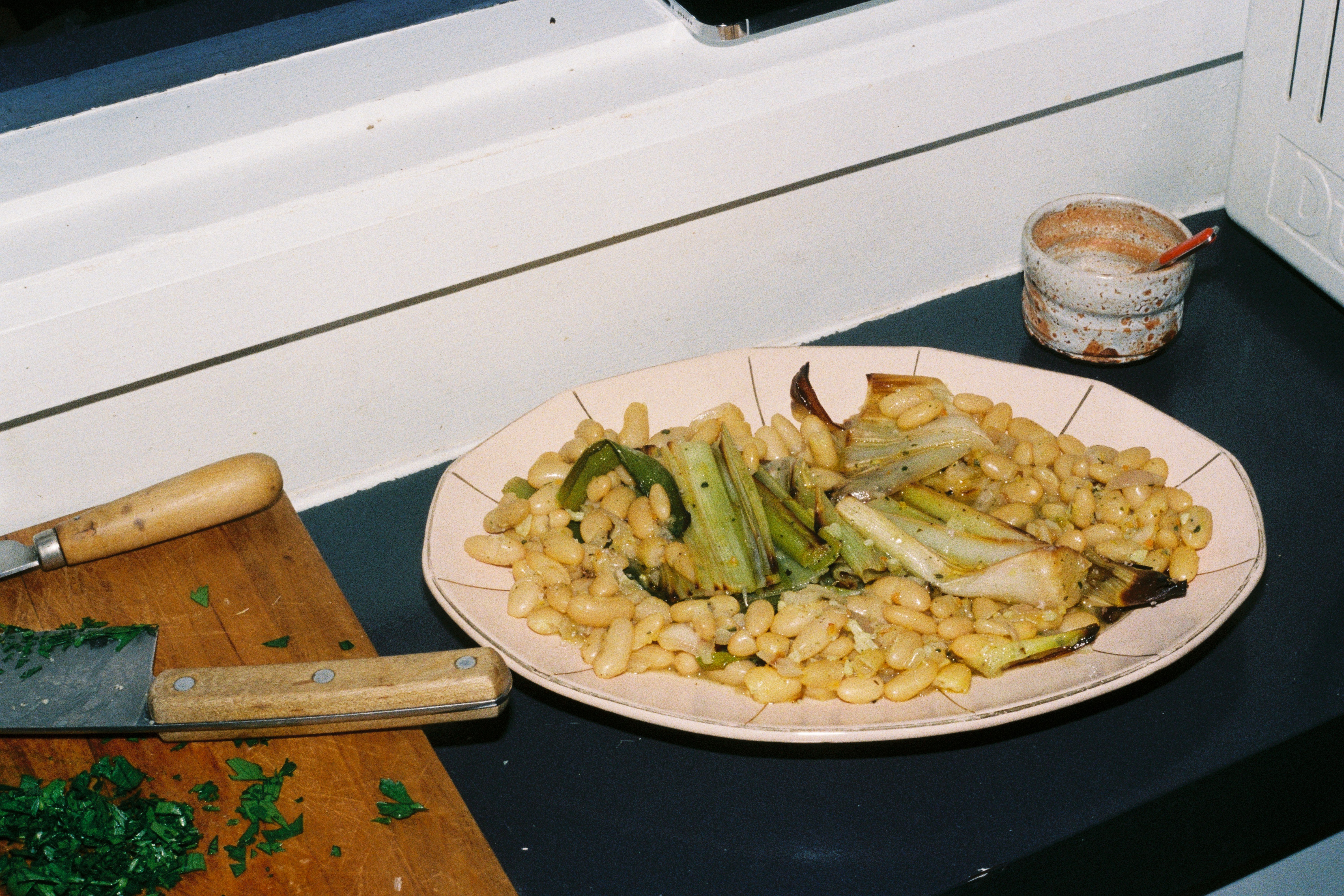Photography by Tracey Creed
Recipe by Amandine Paniagua and Tracey Creed
Words by Tracey Creed
Published March 31 2025
Preheat the oven to 200 degrees Celsius.
Cut the leeks into four similarly sized pieces. Toss generously in olive oil and salt and spread out on a sheet pan. Place on the center rack and roast for 15-20 minutes or until soft and caramelised.
Add 2 tablespoons of olive oil to a medium saucepan and add the shallot and garlic. Over medium heat, cook on high heat for 3-4 minutes.
Next, add the beans and their brine. Reduce the heat. Now, add your stock. Don't let it boil; just bring your heat down to a low simmer for 20 or so minutes. Add 1 tablespoon tamari and pepper to taste.
Remove the leeks from the oven. On a platter or in a big bowl, add your beans and arrange the leeks on top. Season to taste with sea salt and black pepper, and add a big squeeze of lemon. Serve immediately.
This recipe will keep up for up to 2 days refrigerated.
Garlick-y beans, simmered in broth, served with caramelised leeks and a big squeeze of lemon. This is a dish I crave often, usually served with tempeh and a big dose of seasonal greens like butterhead or romaine. Perhaps this meal will help you transition into autumn. Regardless, cannellini beans are an excellent source of protein, 15 grams per cup and will additionally soothe any stagnation. I am drawn to foods that are largely unprocessed. There are a ton of vegan versions of many foods, and I did go through a phase of eating Fry’s nuggets with tomato sauce for a bit, but for me, the foods that I eat and feel the best for eating are whole foods or foods that are low touch—barely processed. So, beans are a food that I incorporate into my meals weekly.
Unlike heavy proteins that can weigh us down, cannellini beans are a clean protein source; vitamins, minerals, phytochemicals, and other micro- and macronutrients are abundant. Much of the focus tends to be on protein and carbohydrates, a macronutrient approach, but collagens are vital constituents of extracellular matrices, accounting for approximately 25–30 percent of the overall total protein composition within the human body. Collagen is of course, a focus in the quest for skin rejuvenation. Many scientific investigations have amassed compelling evidence highlighting the positive impact of hydrolysed collagen supplementation in mitigating the visible signs of skin aging and more recently, it was a YouTube video my partner shared with me discussing the role of glycine in the skin that got me thinking about the amino acid profiles in the foods we eat.
Glycine, proline, and lysine are constituents of the primary protein structure and are required for collagen formation. In the context of plant protein sources, protein quality is associated with the availability of macronutrients such as the essential amino acid lysine, which can be acquired from meals containing beans. Lysine, it turns out, and validated in this research, plays a critical role in the process of post-translational modifications facilitated with enzymes lysyl hydroxylase and lysyl oxidase, which are directly involved in the synthesis and maturation of collagens.
This study also states that collagen biogenesis is influenced by the cellular redox state, which includes important minerals and bioactive chemicals such as iron, copper, and certain quinone cofactors. Just one cup of canned cannelinni or similar white beans are an excellent source of iron since they contain 8 mg of iron or 44% of the daily value. The paper provides a novel perspective on the significant macro- and micronutrients present in the common bean, and concludes that macro- and micronutrients obtained from white beans as a protein source, minerals, and natural bioactive compounds could optimise our bodies' capacity to promote the development and durability of collagen macromolecules within the human body.
Every moment with food is an opportunity to honor our bodies with the gifts of Mother Earth, which connect us with the source. I have come a long way in my relationship with food, and it is this experience that continuously compels me to share what I have learned through this platform. I hope that you find these recipes and writings here useful. Our relationship with food can be very harsh and intense, so I find it most productive to cultivate care, compassion, and to lean into feeling my body—my Bikram practice has further connected me to my body, how it feels, and when it feels best, very dependent on the foods I fuel my body with. I often think we take our bodies and our bodily functions for granted, so being present during routines can be very helpful in connecting to our body in a unique and meaningful way. The more interested you are, the more proactive you are, the more you can feel in your body and the better decisions you can make about your health.
*This content is not intended to be a substitute for professional medical advice. Always seek advice from your health provider before altering your routine.



